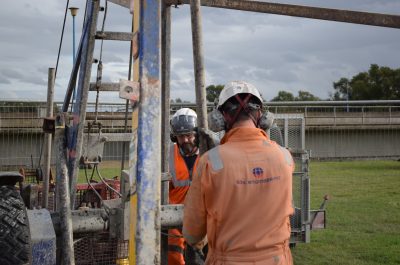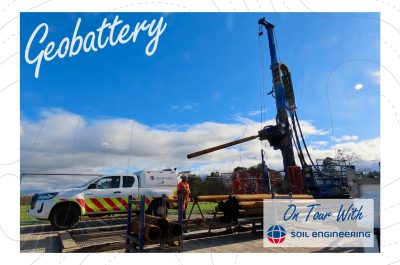Mitchell Street Mine Shaft – A big project, in a small space.
When residents of a Coatbridge street reported a hole in the road outside their houses they didn’t know they it would take major engineering work to sort the problem. But with The Coal Authority stepping in to diagnose and resolve the issue, using specialist Framework Contractor Soil Engineering and working with the community, it’s been a success story of large scale work in a small scale site.
With the hole measuring over 5 metres in width, and impacting both the road construction and services, the Coal Authority first made the site safe working with utilities suppliers, then stabilised the cavity by introducing large volumes of coarse stone to prevent further mass movement. It was immediately clear that a long-term road closure was required, with traffic re-routed around the estate. At this point Soil Engineering were brought in under the Ground Investigation Framework. Undertaking a series of boreholes outside the collapse area, we defined the nature of the overburden, and depth to rock. This allowed The Coal Authority’s Engineers to better define the area at risk.
Bridging the Void
Realising the exclusion area extended over 25 metres in diameter, The Coal Authority then sought to investigate the full extent of the shaft. The span of the exclusion area exceeds even our in-house platform’s capabilities, so an external solution was logical. Providing safe working areas and means of access is a critical planning factor in any investigation. This one simply required a larger scale solution than normal. With the shaft indicated by records to be possibly 300 metres deep, the platform would need to hold one of our largest rigs, and significant quantities of equipment. Expert support was brought in from suppliers Mabey Hire. Their team designed a platform with a total span of 37m, which also required significant temporary works to ensure it remained level on the sloping site.
Collaboratively designed by Mabey Hire and our own internal team, the system required a stable base with concrete piers to ensure levelling. Constructed using Legato blocks. These structures were seated on hardwood Ekki mats to distribute loadings onto the foundations constructed by Soil Engineering’s team. Temporarily extending the road closure to provide a safe build area, the platform was constructed by Mabey Hire’s team, and lifted into position by a 300t crane. A crane working in a residential area, surrounded by houses, constrained by a large hole in the road and the need to maintain access via a footpath close by the edge of the site? Suffice to say the lift planning was complex. Having fitted the road deck to the bridge, the crane then lifted the 15-tonne Soilmec SM-14 required for the drilling on to the platform, along with its tooling.
Investigation
A series of holes were drilled across the collapse area to identify the likely location of the shaft walls, indicating a diameter of around 2.5m. The rig was then positioned centrally over the collapse area, based upon assessments by the Coal Authority’s Engineers. Using water flush to keep the hole clear without ejecting material from the shaft, the rig advanced through the fill material emplaced by the Coal Authority, and into a complex environment of partially collapsed shaft lining, staging and debris from the failure itself. The shaft bottom was proven at 302m below street level, which sets a new record for Soil Engineering’s fleet.
Treatment
Having cased the hole to the base of the shaft, The Coal Authority’s Engineers decided that immediate grouting of the voids apparent at depth was the most prudent course of action. Grout was emplaced throughout the shaft to infill large scale voids beneath a staging with in the shaft, and then to consolidate the fill material placed into the collapsed area. Injecting nearly 700t tonnes of PFA-Cement grout achieved a good degree of consolidation, using twenty two cased holes.
In order to safeguard against any further small-scale settlement in the complex mixed fill created by the collapse, backfilling and grouting, and provide a fully stabilised platform for carriageway reconstruction, further specialist grouting was completed in shallow holes. A network of 150 boreholes were drilled into and around the shaft to facilitate this. After design consultations between The Coal Authority, Soil Engineering and Master Builders (our specialist material supplier) it was decided that a resin grout was the most appropriate approach. Injected via a downhole mixer system, this ultra-penetrative material rendered the shallow materials into a totally consolidated raft 35m thick.
Handback and move on…
Having occupied the site for over 6 months, Soil Engineering recently completed demobilisation of the final project resources, having said farewell to the giant bridge in March, prior to final resin injections beneath its footprint. the site has been handed back to The Coal Authority to allow the road to be fully reinstated. As our team move on to other projects, we’d like to thank the Coal Authority, our specialist suppliers Mabey and Master Builders, but most importantly the residents of Mitchell Street and the community. Without their patience and understanding the logistics of the project could have been much more complex.



